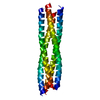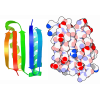[English] 日本語
 Yorodumi
Yorodumi- PDB-8gl3: De novo design of monomeric helical bundles for pH-controlled mem... -
+ Open data
Open data
- Basic information
Basic information
| Entry | Database: PDB / ID: 8gl3 | |||||||||
|---|---|---|---|---|---|---|---|---|---|---|
| Title | De novo design of monomeric helical bundles for pH-controlled membrane lysis | |||||||||
 Components Components | pRLB-519 | |||||||||
 Keywords Keywords | DE NOVO PROTEIN / protein design / pH-responsive / membrane lysis | |||||||||
| Biological species | synthetic construct (others) | |||||||||
| Method |  X-RAY DIFFRACTION / X-RAY DIFFRACTION /  SYNCHROTRON / SYNCHROTRON /  MOLECULAR REPLACEMENT / Resolution: 2.3 Å MOLECULAR REPLACEMENT / Resolution: 2.3 Å | |||||||||
 Authors Authors | Goldbach, N. / Bera, A.K. / Baker, D. / Kang, A. | |||||||||
| Funding support |  United States, 2items United States, 2items
| |||||||||
 Citation Citation |  Journal: Protein Sci / Year: 2023 Journal: Protein Sci / Year: 2023Title: De novo design of monomeric helical bundles for pH-controlled membrane lysis. Authors: Nicolas Goldbach / Issa Benna / Basile I M Wicky / Jacob T Croft / Lauren Carter / Asim K Bera / Hannah Nguyen / Alex Kang / Banumathi Sankaran / Erin C Yang / Kelly K Lee / David Baker /   Abstract: Targeted intracellular delivery via receptor-mediated endocytosis requires the delivered cargo to escape the endosome to prevent lysosomal degradation. This can in principle be achieved by membrane ...Targeted intracellular delivery via receptor-mediated endocytosis requires the delivered cargo to escape the endosome to prevent lysosomal degradation. This can in principle be achieved by membrane lysis tightly restricted to endosomal membranes upon internalization to avoid general membrane insertion and lysis. Here, we describe the design of small monomeric proteins with buried histidine containing pH-responsive hydrogen bond networks and membrane permeating amphipathic helices. Of the 30 designs that were experimentally tested, all expressed in Escherichia coli, 13 were monomeric with the expected secondary structure, and 4 designs disrupted artificial liposomes in a pH-dependent manner. Mutational analysis showed that the buried histidine hydrogen bond networks mediate pH-responsiveness and control lysis of model membranes within a very narrow range of pH (6.0-5.5) with almost no lysis occurring at neutral pH. These tightly controlled lytic monomers could help mediate endosomal escape in designed targeted delivery platforms. | |||||||||
| History |
|
- Structure visualization
Structure visualization
| Structure viewer | Molecule:  Molmil Molmil Jmol/JSmol Jmol/JSmol |
|---|
- Downloads & links
Downloads & links
- Download
Download
| PDBx/mmCIF format |  8gl3.cif.gz 8gl3.cif.gz | 110.6 KB | Display |  PDBx/mmCIF format PDBx/mmCIF format |
|---|---|---|---|---|
| PDB format |  pdb8gl3.ent.gz pdb8gl3.ent.gz | 70.9 KB | Display |  PDB format PDB format |
| PDBx/mmJSON format |  8gl3.json.gz 8gl3.json.gz | Tree view |  PDBx/mmJSON format PDBx/mmJSON format | |
| Others |  Other downloads Other downloads |
-Validation report
| Summary document |  8gl3_validation.pdf.gz 8gl3_validation.pdf.gz | 400.3 KB | Display |  wwPDB validaton report wwPDB validaton report |
|---|---|---|---|---|
| Full document |  8gl3_full_validation.pdf.gz 8gl3_full_validation.pdf.gz | 401.8 KB | Display | |
| Data in XML |  8gl3_validation.xml.gz 8gl3_validation.xml.gz | 5.5 KB | Display | |
| Data in CIF |  8gl3_validation.cif.gz 8gl3_validation.cif.gz | 7.1 KB | Display | |
| Arichive directory |  https://data.pdbj.org/pub/pdb/validation_reports/gl/8gl3 https://data.pdbj.org/pub/pdb/validation_reports/gl/8gl3 ftp://data.pdbj.org/pub/pdb/validation_reports/gl/8gl3 ftp://data.pdbj.org/pub/pdb/validation_reports/gl/8gl3 | HTTPS FTP |
-Related structure data
- Links
Links
- Assembly
Assembly
| Deposited unit | 
| ||||||||||||
|---|---|---|---|---|---|---|---|---|---|---|---|---|---|
| 1 |
| ||||||||||||
| Unit cell |
|
- Components
Components
| #1: Protein | Mass: 27599.225 Da / Num. of mol.: 1 Source method: isolated from a genetically manipulated source Source: (gene. exp.) synthetic construct (others) / Production host:  |
|---|---|
| #2: Water | ChemComp-HOH / |
-Experimental details
-Experiment
| Experiment | Method:  X-RAY DIFFRACTION / Number of used crystals: 1 X-RAY DIFFRACTION / Number of used crystals: 1 |
|---|
- Sample preparation
Sample preparation
| Crystal | Density Matthews: 2.4 Å3/Da / Density % sol: 48.2 % |
|---|---|
| Crystal grow | Temperature: 293 K / Method: vapor diffusion, sitting drop / pH: 8 / Details: 0.2 M Sodium fluoride and 20% (w/v) PEG 3350 |
-Data collection
| Diffraction | Mean temperature: 100 K / Serial crystal experiment: N |
|---|---|
| Diffraction source | Source:  SYNCHROTRON / Site: SYNCHROTRON / Site:  ALS ALS  / Beamline: 8.2.2 / Wavelength: 0.99998 Å / Beamline: 8.2.2 / Wavelength: 0.99998 Å |
| Detector | Type: DECTRIS PILATUS 6M / Detector: PIXEL / Date: Nov 4, 2022 |
| Radiation | Protocol: SINGLE WAVELENGTH / Monochromatic (M) / Laue (L): M / Scattering type: x-ray |
| Radiation wavelength | Wavelength: 0.99998 Å / Relative weight: 1 |
| Reflection | Resolution: 2.3→45.64 Å / Num. obs: 11502 / % possible obs: 98.36 % / Redundancy: 3.3 % / Biso Wilson estimate: 23.78 Å2 / CC1/2: 0.998 / Rmerge(I) obs: 0.082 / Rpim(I) all: 0.052 / Net I/σ(I): 10.5 |
| Reflection shell | Resolution: 2.3→2.53 Å / Redundancy: 3.4 % / Rmerge(I) obs: 0.144 / Mean I/σ(I) obs: 7.39 / Num. unique obs: 2812 / CC1/2: 0.976 / Rpim(I) all: 0.091 / % possible all: 98.13 |
- Processing
Processing
| Software |
| ||||||||||||||||||||||||||||||||||||||||
|---|---|---|---|---|---|---|---|---|---|---|---|---|---|---|---|---|---|---|---|---|---|---|---|---|---|---|---|---|---|---|---|---|---|---|---|---|---|---|---|---|---|
| Refinement | Method to determine structure:  MOLECULAR REPLACEMENT / Resolution: 2.3→45.64 Å / SU ML: 0.2172 / Cross valid method: FREE R-VALUE / σ(F): 1.42 / Phase error: 29.0929 MOLECULAR REPLACEMENT / Resolution: 2.3→45.64 Å / SU ML: 0.2172 / Cross valid method: FREE R-VALUE / σ(F): 1.42 / Phase error: 29.0929 Stereochemistry target values: GeoStd + Monomer Library + CDL v1.2
| ||||||||||||||||||||||||||||||||||||||||
| Solvent computation | Shrinkage radii: 0.9 Å / VDW probe radii: 1.1 Å / Solvent model: FLAT BULK SOLVENT MODEL | ||||||||||||||||||||||||||||||||||||||||
| Displacement parameters | Biso mean: 46.04 Å2 | ||||||||||||||||||||||||||||||||||||||||
| Refinement step | Cycle: LAST / Resolution: 2.3→45.64 Å
| ||||||||||||||||||||||||||||||||||||||||
| Refine LS restraints |
| ||||||||||||||||||||||||||||||||||||||||
| LS refinement shell |
| ||||||||||||||||||||||||||||||||||||||||
| Refinement TLS params. | Method: refined / Origin x: 8.879 Å / Origin y: -7.312 Å / Origin z: 36.152 Å
| ||||||||||||||||||||||||||||||||||||||||
| Refinement TLS group | Selection details: ( CHAIN A AND RESID 6:221 ) |
 Movie
Movie Controller
Controller





 PDBj
PDBj

